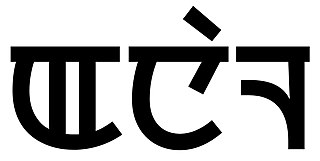Related Research Articles

Anal or Anāl, also known as Pakan Naga, after the two principal villages where it is spoken in, is a Southern Naga language, part of the Sino-Tibetan language family, spoken by the Anal people in India and a dwindling number in Myanmar. It had 83,000 speakers in India according to the 2001 census, and 55,000 in Myanmar in 2010. It has two principal clans, Murchal and Moshum, and is closest to Lamkang. The language of wider communication is Meitei language. The name "Anal" was given by the Meitei people of Manipur valley. Anal is written in the Latin script, with a literacy rate of about 87%. The speakers of this language use Meitei language as their second language (L2) according to the Ethnologue.
Jingpho or Kachin, is a Tibeto-Burman language of the Sal branch mainly spoken in Kachin State, Burma and Yunnan, China. There are many meanings for Jingpho. In the Jingpho language, Jingpho means people or Jinghpho tribe. The term "Kachin language" can refer either to the Jingpho language or to a group of languages spoken by various ethnic groups in the same region as Jingpo: Lisu, Lashi, Rawang, Zaiwa, Lhao Vo, Achang and Jingpho. These languages are from distinct branches of the highest level of the Tibeto-Burman family. The Jingpho alphabet is based on the Latin script.

Tangkhul is a Sino-Tibetan language of the Tangkhulic branch, spoken in 168 villages of Ukhrul district, Manipur, India. The term "Tangkhul" is derived from the Meitei language terms, "Tang" meaning "scarce" and "Khul" meaning "village" respectively. According to another theory, the term "Tangkhul" is derived from "Thankhul", meaning "Than village" in Meitei language.
Falam Chin is a Kuki-Chin language in Falam Township, Chin State, Myanmar, and also in Mizoram, India.
Khumi or Khumi Chin, is a Kuki-Chin-Mizo language of Burma, with some speakers across the border in Bangladesh. Khumi shares 75%–87% lexical similarity with Eastern Khumi, and 78-81% similarity with Mro-Khimi.
Rawang, also known as Krangku, Kiutze (Qiuze), and Ch’opa, is a Sino-Tibetan language of India and Burma. Rawang has a high degree of internal diversity, and some varieties are not mutually intelligible. Most, however, understand Mutwang (Matwang), the standard dialect, and basis of written Rawang.
Karenni or Red Karen, known in Burmese as Kayah, is a Karen dialect continuum spoken by over half a million Kayah people in Burma.
Moklen is an Austronesian language spoken on the western coast of southern Thailand. It is related to but distinct from the Moken language of Myanmar and southern Thailand. Unlike Moken, it is not spoken in Myanmar.
Lamkang is a Tibeto-Burman language of Southern Naga linguistic sub branch. It is spoken by the Lamkang Nagas of Manipur, India, with one village in Burma. The Lamkangs mostly live in the southwest and southeastern parts of Manipur.

Monsang is an unclassified Sino-Tibetan language spoken in the Northeast of India. Scott DeLancey, et al. (2015) classifies Monsang as a "Northwest Naga" language. The speakers of this language use Meitei language as their second language (L2) according to the Ethnologue.

Tarao, or Taraotrong, is an unclassified Tibeto-Burman language of India. It is marginally (70%) intelligible with Chothe. The speakers of this language use Meitei language as their second language (L2) according to the Ethnologue.
Moyon is a Sino-Tibetan language of Southern Naga linguistic sub branch. It is spoken by the Moyon peoples in Manipur, India and in Burma.
Leinong Naga, or Htang Ngan, is a Sino-Tibetan language spoken in Burma. Leinong Naga is spoken in about 25 villages of Lahe Township and northwestern Hkamti Township, Naga Self-Administered Zone, Sagaing Division, Myanmar (Ethnologue). Dialects are Yao Dyang and Southern Leinong (Ethnologue).
Ponyo, or Ponyo-Gongwang after its two dialects, is a Sino-Tibetan language spoken in Burma. Ponyo is spoken in 19 villages of Lahe Township, Naga Self-Administered Zone, Sagaing Division, Myanmar (Ethnologue). Dialects are Ponyo and Gongwang, with high mutual intelligibility between the two, both of which share 89% to 91% lexical similarity.
Koki, or Koki Naga, is an unclassified Sino-Tibetan language spoken in Burma. Speakers are included under the wider Naga ethnicity. It has been documented in Shintani (2018).
Long Phuri, or Long Phuri Naga, is an unclassified Naga language of Burma. Long Phuri is spoken in 6 villages of Leshi Township, Hkamti District, Sagaing Region, Myanmar.
Para or Para Naga, is an unclassified Naga language of India and Burma. It is not close to other Naga languages which it has been compared to, though Para Naga, Long Phuri Naga, and Makuri Naga may be closest to each other, with Para the most distinct. Barkman (2014) notes that Para Naga could possibly be an Ao or Tangkhulic language. Saul (2005) classifies Para Naga as an Ao language. Hsiu (2021) classifies Para as a sister of the Central Naga (Ao) languages.
Makyam Naga is a Sino-Tibetan language spoken in Myanmar. The Western Makyam Naga dialects share 99% lexical similarity.

Kharam is a Southern Naga language of India. Peterson (2017) classifies the closely related Purum language as part of the Northwestern branch of Kuki-Chin. According Ethnologue, Kharam shares a high degree of mutual intelligibility with Purum. The speakers of this language use Meitei language as their second language (L2) according to the Ethnologue.
Ganan is a Sino-Tibetan language of northwestern Myanmar, spoken in Sagaing Region. It belongs to the Luish branch, and is most closely related to the Kadu language of Myanmar, with which it shares 84 to 89% lexical similarity. The Ganan dialects share 95 to 99% lexical similarity.
References
- 1 2 Chothe at Ethnologue (18th ed., 2015) (subscription required)
- ↑ DeLancey, Scott; Krishna Boro; Linda Konnerth1; Amos Teo. 2015. Tibeto-Burman Languages of the Indo-Myanmar borderland. 31st South Asian Languages Analysis Roundtable, 14 May 2015
